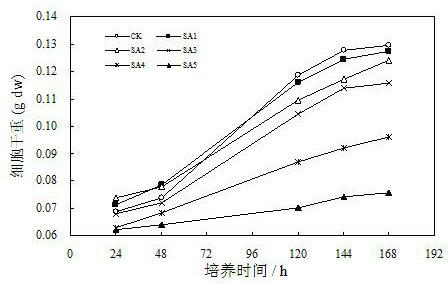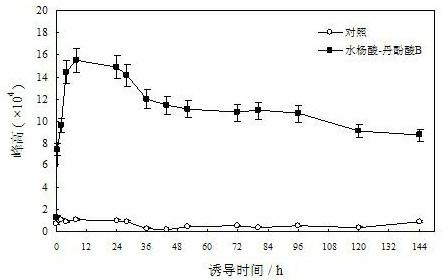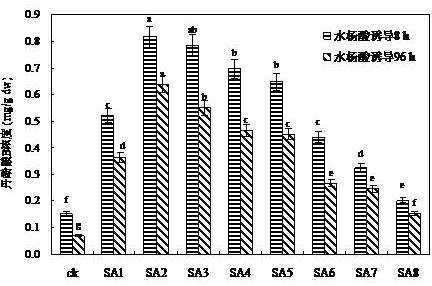Method for improving yield of salvianolic acid B in savia miltiorrhiza suspension culture cells by inducing
A technique for culturing cells in suspension and salvianolic acid, which is applied in horticultural methods, botanical equipment and methods, horticulture and other directions to achieve the effects of avoiding low efficiency, short induction time and simple process.
- Summary
- Abstract
- Description
- Claims
- Application Information
AI Technical Summary
Problems solved by technology
Method used
Image
Examples
Embodiment 1
[0045] Fresh Salvia miltiorrhiza seeds were induced to grow sterile seedlings on MS solid medium. The leaves of robust sterile seedlings were selected, cut into small pieces of 0.5 cm × 0.5 cm, and inoculated on MS solid induction medium (containing 1.0 mg / L NAA, 0.5 mg / L 6-BA, 0.5 mg / L 2,4-D, 5.5 g / L agar, 30 g / L sucrose) to induce callus formation. The calli with stable morphological characteristics and growth rate were cultured for one month under the culture conditions of culture temperature of 26°C, light time of 12-16 h, and light intensity of 2000-3000 Lx. Select fresh and loose solid callus, disperse under sterile conditions, transfer the dispersed callus to MS liquid medium (without containing agar and growth regulators, with 30 g / L sucrose), in dark suspension cultures in a shaker. Suspension culture conditions: culture temperature was 25°C, rotation speed was 125 rpm, cultured for 5 days. Add salicylic acid elicitor at a final concentration of 10 mg / L to the medi...
Embodiment 2
[0047] Fresh Salvia miltiorrhiza seeds were induced to grow sterile seedlings on MS solid medium. The leaves of robust sterile seedlings were selected, cut into small pieces of 0.5 cm × 0.5 cm, and inoculated on MS solid induction medium (containing 1.5 mg / L NAA, 0.5 mg / L 6-BA, 0.5 mg / L 2,4-D, 5.5 g / L agar, 30 g / L sucrose) to induce callus formation. The calli with stable morphological characteristics and growth rate were cultured for 1 month under the conditions of culture temperature of 24 °C, light time of 12-16 h, and light intensity of 2000-3000 Lx. Select fresh and loose solid callus, disperse under sterile conditions, transfer the dispersed callus to MS liquid medium (without containing agar and growth regulators, with 30 g / L sucrose), in dark suspension cultures in a shaker. Suspension culture conditions: culture temperature was 25°C, rotation speed was 125 rpm, cultured for 8 days. Add salicylic acid elicitor at a final concentration of 12.5 mg / L to the medium for ...
Embodiment 3
[0049] Fresh Salvia miltiorrhiza seeds were induced to grow sterile seedlings on MS solid medium. The leaves of robust sterile seedlings were selected, cut into small pieces of 0.5 cm × 0.5 cm, and inoculated on MS solid induction medium (containing 1.0 mg / L NAA, 1.5 mg / L 6-BA, 0.5 mg / L 2,4-D, 5.5 g / L agar, 30 g / L sucrose) to induce callus formation. The calli with stable morphological characteristics and growth rate were cultured for 1 month under the culture conditions of culture temperature of 27 °C, light time of 12-16 h, and light intensity of 2000-3000 Lx. Select fresh and loose solid callus, disperse under sterile conditions, transfer the dispersed callus to MS liquid medium (without containing agar and growth regulators, with 30 g / L sucrose), in dark suspension cultures in a shaker. Suspension culture conditions: culture temperature was 25°C, rotation speed was 125 rpm, cultured for 4 days. The salicylic acid elicitor at a final concentration of 6.25 mg / L was added ...
PUM
 Login to View More
Login to View More Abstract
Description
Claims
Application Information
 Login to View More
Login to View More - R&D
- Intellectual Property
- Life Sciences
- Materials
- Tech Scout
- Unparalleled Data Quality
- Higher Quality Content
- 60% Fewer Hallucinations
Browse by: Latest US Patents, China's latest patents, Technical Efficacy Thesaurus, Application Domain, Technology Topic, Popular Technical Reports.
© 2025 PatSnap. All rights reserved.Legal|Privacy policy|Modern Slavery Act Transparency Statement|Sitemap|About US| Contact US: help@patsnap.com



